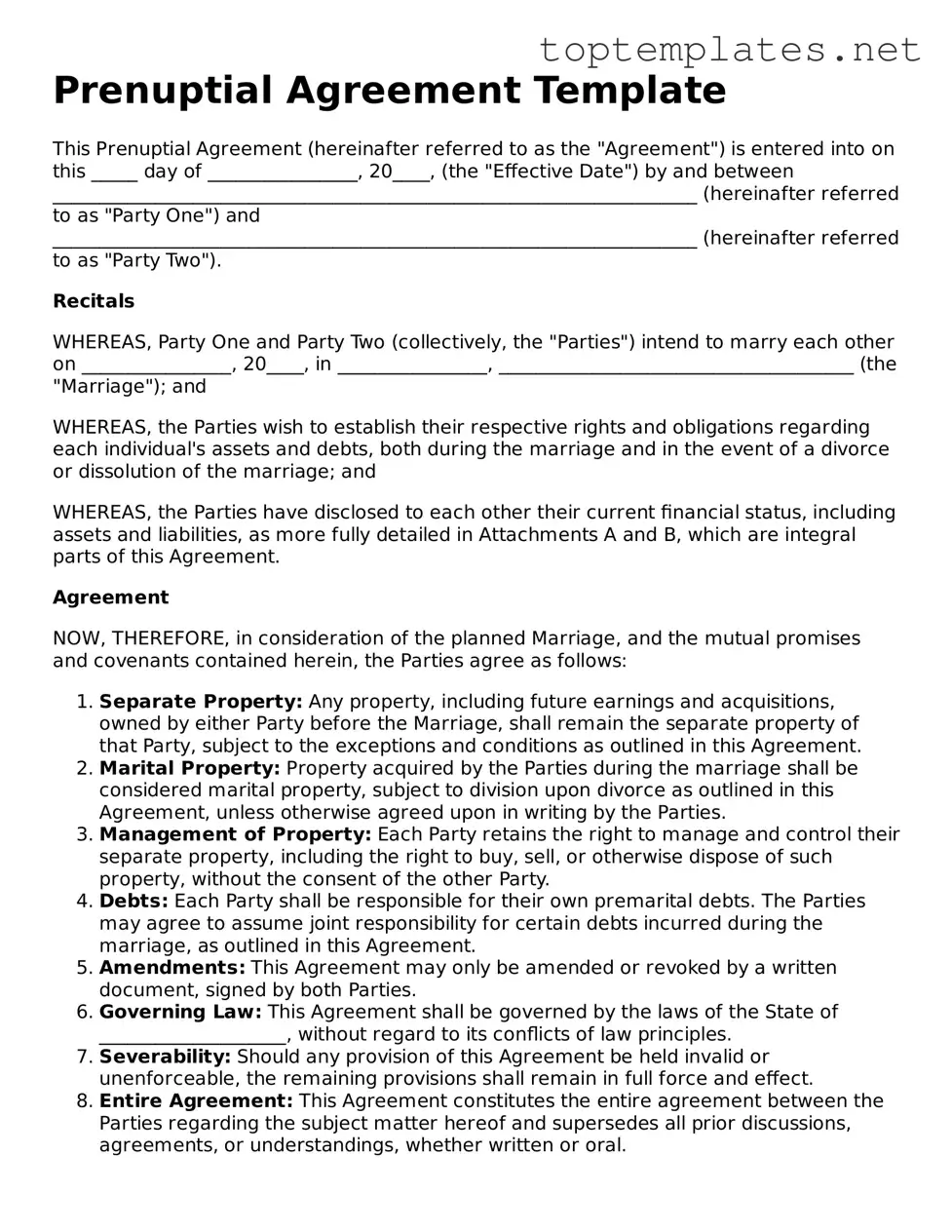Prenuptial Agreement Template
This Prenuptial Agreement (hereinafter referred to as the "Agreement") is entered into on this _____ day of ________________, 20____, (the "Effective Date") by and between _____________________________________________________________________ (hereinafter referred to as "Party One") and _____________________________________________________________________ (hereinafter referred to as "Party Two").
Recitals
WHEREAS, Party One and Party Two (collectively, the "Parties") intend to marry each other on ________________, 20____, in ________________, ______________________________________ (the "Marriage"); and
WHEREAS, the Parties wish to establish their respective rights and obligations regarding each individual's assets and debts, both during the marriage and in the event of a divorce or dissolution of the marriage; and
WHEREAS, the Parties have disclosed to each other their current financial status, including assets and liabilities, as more fully detailed in Attachments A and B, which are integral parts of this Agreement.
Agreement
NOW, THEREFORE, in consideration of the planned Marriage, and the mutual promises and covenants contained herein, the Parties agree as follows:
- Separate Property: Any property, including future earnings and acquisitions, owned by either Party before the Marriage, shall remain the separate property of that Party, subject to the exceptions and conditions as outlined in this Agreement.
- Marital Property: Property acquired by the Parties during the marriage shall be considered marital property, subject to division upon divorce as outlined in this Agreement, unless otherwise agreed upon in writing by the Parties.
- Management of Property: Each Party retains the right to manage and control their separate property, including the right to buy, sell, or otherwise dispose of such property, without the consent of the other Party.
- Debts: Each Party shall be responsible for their own premarital debts. The Parties may agree to assume joint responsibility for certain debts incurred during the marriage, as outlined in this Agreement.
- Amendments: This Agreement may only be amended or revoked by a written document, signed by both Parties.
- Governing Law: This Agreement shall be governed by the laws of the State of ____________________, without regard to its conflicts of law principles.
- Severability: Should any provision of this Agreement be held invalid or unenforceable, the remaining provisions shall remain in full force and effect.
- Entire Agreement: This Agreement constitutes the entire agreement between the Parties regarding the subject matter hereof and supersedes all prior discussions, agreements, or understandings, whether written or oral.
IN WITNESS WHEREOF, the Parties have executed this Agreement as of the Effective Date first above written.
Party One: ___________________________________________
Party Two: ___________________________________________
Date: _______________________________________________
Notary Acknowledgment
State of ____________________
County of ___________________
On this _____ day of ________________, 20____, before me, the undersigned notary public, personally appeared _____________________________________ and ______________________________________, known to me (or satisfactorily proven) to be the persons whose names are subscribed to the within instrument and acknowledged that they executed the same for the purposes therein contained.
In witness whereof, I hereunto set my hand and official seal.
Notary Public: ________________________________________
My Commission Expires: ________________________________
